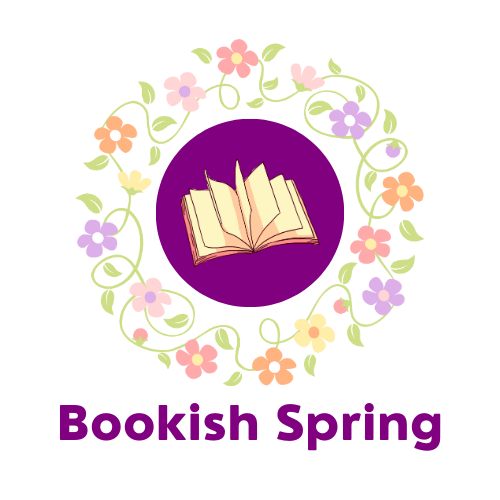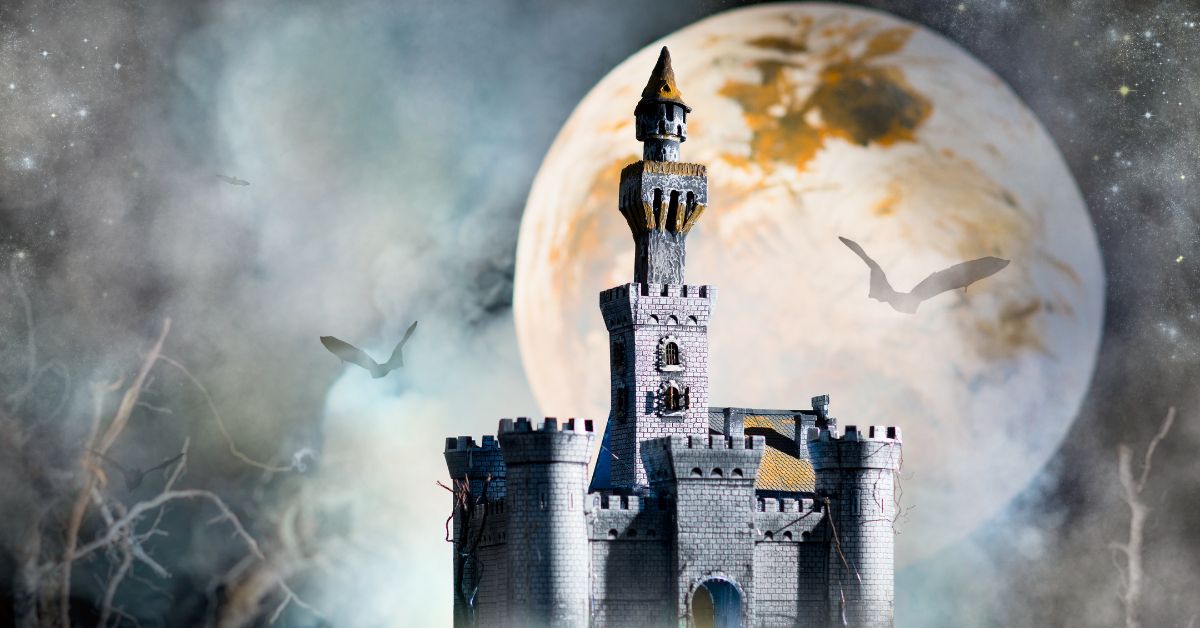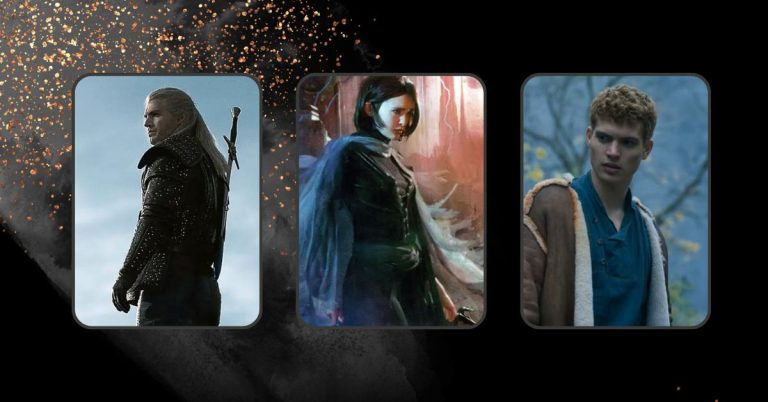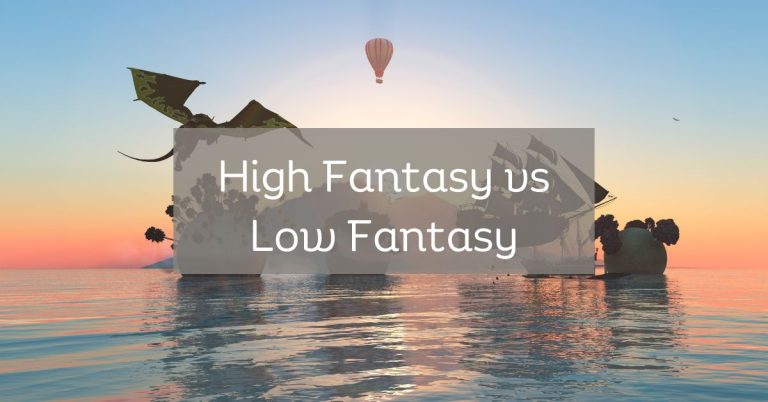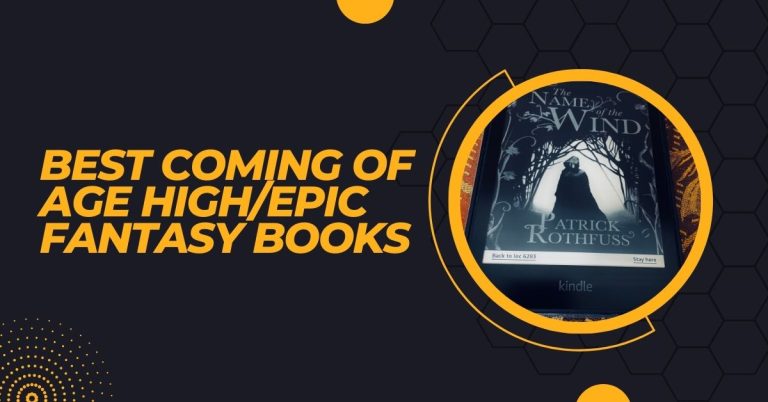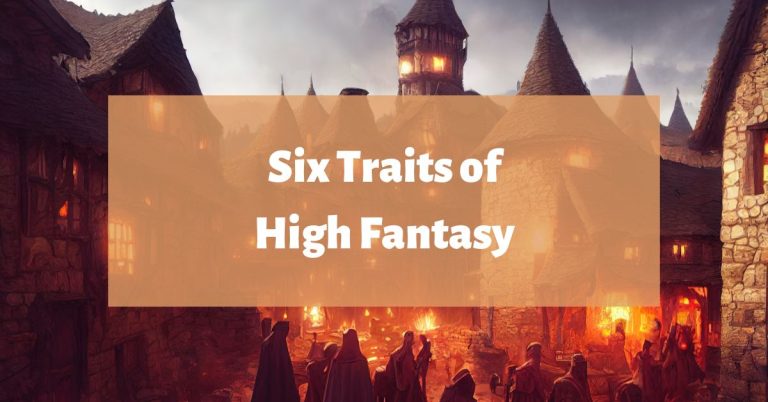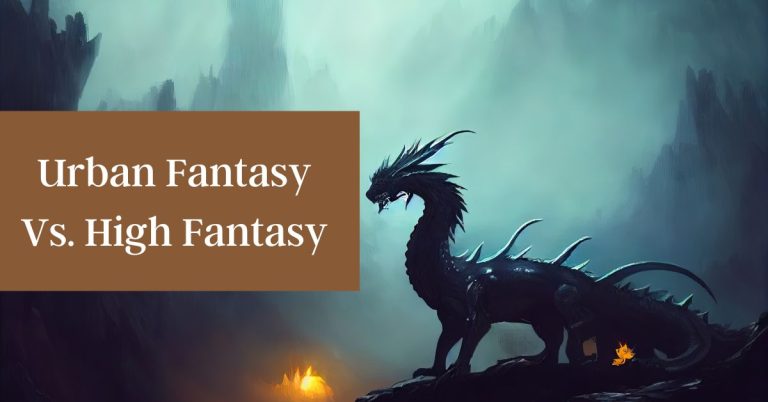History of Epic Fantasy: From the Beginning till Now
In the wide canvas of world literature, few genres can transport readers to worlds as intricate, sprawling, and spellbinding as high and epic fantasy. The history of high or epic fantasy is not just about mesmerizing tales of dragons, elves, and magic but also a reflection of the power of human imagination and the history of the world itself.
But how and where the journey of this genre started? How did these tales, set against the backdrop of fictional realms and sprawling landscapes, come to dominate our bookshelves and screens?
High fantasy history is a tapestry of diverse origins. Drawing inspiration from ancient myths, legends, and human desires, it’s woven with threads of hope, conflict, and heroism. Over time, as civilizations grew and cultures merged, these stories have grown deeper and more complex, becoming tales that are more than just escapism. They offer insights into human nature, societal structures, and the timeless battle of good versus evil.
The journey from the whispered tales around ancient campfires to the blockbuster movies and bestselling novels of today is nothing short of magical. As we embark on this voyage to uncover the history of these genres, we’ll explore the visionaries who transformed simple tales into epic sagas and dive into the intricacies of worlds that, while fictional, feel as real as our own.
So, prepare to venture into the realm of the magnificent, where heroes rise, empires fall, and magic is as tangible as the ground beneath your feet.
What exactly is high/Epic fantasy?
Before we dive into the history of high/epic fantasy, let’s briefly talk about what defines high or epic fantasy. Although many argue that these two subgenres of fantasy are different, and there is some truth to it; however, they are mostly the same.
For starters, a high and epic fantasy are both set in a secondary world entirely imagined by the writer. The process of creating an imaginary secondary world is called Fantasy Worldbuilding. To qualify as high fantasy, a story must feature a secondary world imagined by the author that generally has its own culture, geography, magic system, mythical creatures, etc.
When it comes to epic fantasy, the story is set in a secondary world, but the scale is epic – it has a vast cast of characters, a gigantic world with diverse cultures, races of humans, and other human creatures, and mostly features a medieval theme and an epic journey of the hero or a band of heroes such as in Tolkien’s classic The Hobbit or Lord of the Rings.
Ancient roots: From myth to modern fantasy
Before the rise of bestselling fantasy novels and blockbuster films such as The Lord of the Rings or A Song of Ice and Fire, or The Witcher, stories of magic, quests, and heroes were spun around campfires and etched into ancient tablets.
The Groundwork for today’s high and epic fantasy was laid by these myths and legends from all across the globe. One of the earliest works of literature, the Epic of Gilgamesh, originated from ancient Mesopotamia (modern-day Iraq) and was, in fact, a fantasy tale.
The story featured a god-king and his mate Enkidu who tackled impossible cosmic obstacles and confronted their mortality. Sound familiar, right? The themes from this ancient epic resonate in many of today’s epic fantasy tales, where quests for knowledge and self-understanding drive the plot.
Heading over to the chilly coasts of Scandinavia, the Norse sagas come alive with tales of gods, giants, and heroes. Odin, Thor, and Loki are names many recognize, thanks to their resurgence in pop culture.
But these deities, in their original legends, offered a rich tapestry of stories that showcased heroism, betrayal, and fate. J.R.R. Tolkien, a legend in high fantasy, borrowed heavily from Norse mythology, with creatures like elves and dwarves and themes of epic quests and cosmic destinies reflected in his works.
Then there’s Beowulf, an Old English epic that dives deep into the hero’s combat with the monstrous Grendel and a ferocious dragon. The dark and haunting atmosphere of this poem, alongside the battle between man and mythical beasts, can be seen influencing various modern fantasy tales, including the likes of George R.R. Martin’s A Song of Ice and Fire.
However, it wasn’t just the West churning out legendary tales. In the East, epics like the Ramayana and Mahabharata from ancient India introduced a vast array of characters, magical weapons, and moral dilemmas.
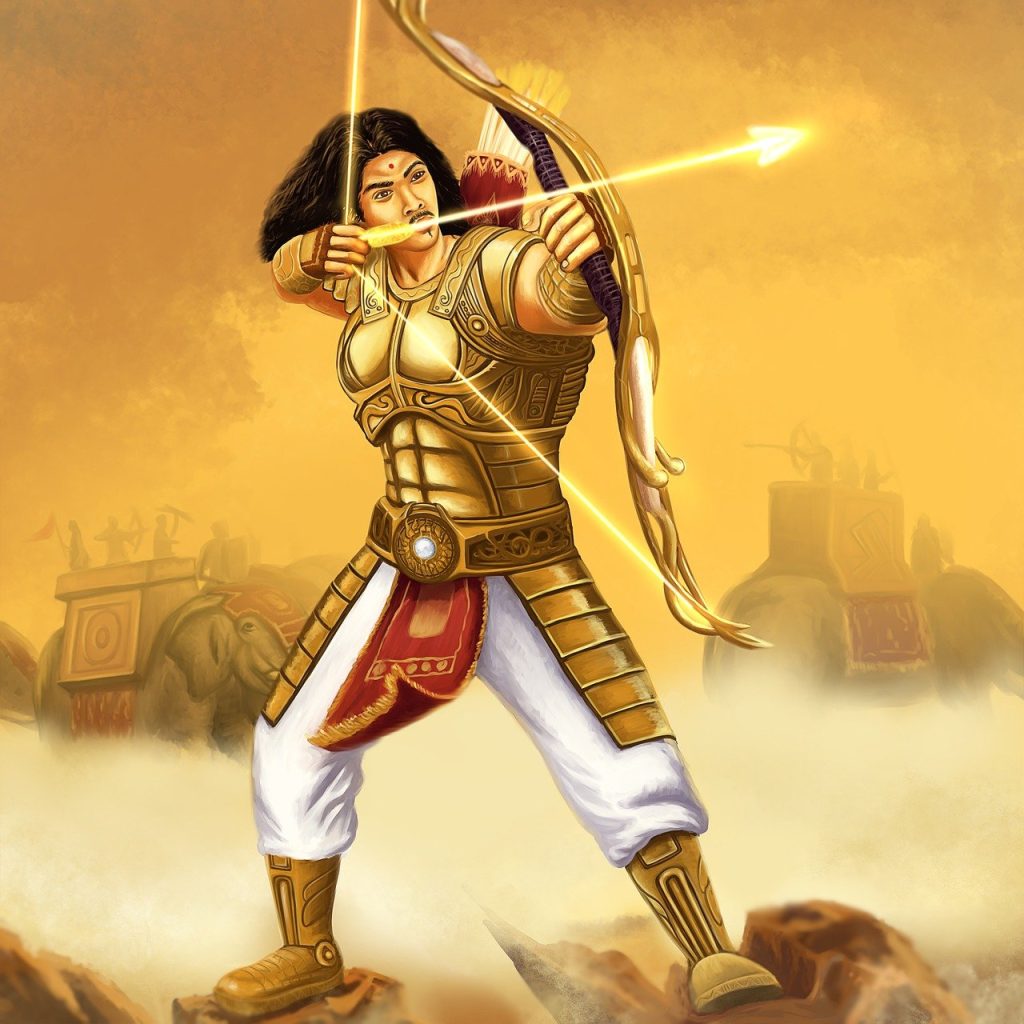
(Arjuna from Mahabharata) Credit: Pixabay
Elements from these tales, such as enchanted weapons or morally gray characters, are common tropes and elements of modern high and epic fantasy. Similarly, Chinese folklore brought to life mythical creatures such as dragons, phoenixes, and spirits – entities that have since become staple creatures in the fantasy genre.
Today’s authors often draw upon these myths, molding them into fresh narratives while paying homage to their origins. In essence, as we leaf through the pages of high and epic fantasy, we’re also traversing through ages, cultures, and legends that have been passed down through millennia.
The genius of modern fantasy writers lies not just in crafting new worlds but in how they weave these ancient threads, drawing inspiration from myths and legends across the globe to spin tales that resonate across time.
The first ever high fantasy novel: Well at the World’s End by William Morris
In the late 1800s, a new book by William Morris got published and changed the world of literature forever. William Morris was a man of many talents, an artist, poet, and author. When his book The Well at the World’s End dropped in 1896, it wasn’t just another novel on the shelf; it was the blueprint for what high fantasy could be.
Over the years, it’s been reprinted loads of times, even landing spots in the Ballantine Adult Fantasy series in the 70s. Many say it’s the grandfather of all high fantasy novels and is widely regarded as the first ever true high fantasy novel ever written.
This isn’t your usual once-upon-a-time deal. It’s a rollercoaster ride of trickery, burning passions, and some good old magic. Instead of the usual fairy-laden plot, Morris threw a curveball – a fairy tale without the fairies!
What makes this book pop isn’t just the story; it’s how Morris told it. Picture this: a mix of a bold, ahead-of-its-time fantasy and a throwback to those cozy bedtime tales. The man didn’t just write; he painted with words. Every chapter feels like you’re walking through a vivid dream, which makes sense, given Morris was also a top-tier decorative artist.
In a nutshell, The Well at the World’s End isn’t just a fantasy novel to read; it’s the one that sets the stage for the fantasies we love today, showing that there’s no limit when it comes to firing up our imagination.
The origin of the term high fantasy
The phrase high fantasy might feel as ancient as the tales it describes, but its origin is relatively recent. The credit for coining this evocative term goes to Lloyd Alexander, an influential figure in the world of fantasy literature. In 1971, he wrote an article titled High Fantasy and Heroic Romance. The essay explained his ideas and thoughts about the allure and nature of such a style of storytelling.
What’s interesting is that the genesis of this essay was a presentation he gave two years earlier at the New England Round Table of Children’s Librarians in 1969. In his discourse, Alexander aimed to define and distinguish the grandeur and epic scope of high fantasy from other forms of fantastical tales.
Over time, his terminology gained traction and became a staple in literary circles, aptly capturing the essence of stories that transport readers to wholly imagined realms rich with lore, heroism, and magic.
The early 20th century: The Era of j.R.R Tolkien
Roll back the clock to the 1900s. While the world was marveling at new inventions and jiving to emerging music genres, the literary world got a dynamo: J.R.R. Tolkien. On 21 September 1937, the world got introduced with the first true epic fantasy novel: The Hobbit, which featured an imaginary world called Middle Earth. Tolkien’s Middle-earth wasn’t just a backdrop for a story; it was Tolkien’s labor of love, an expansive universe with its own languages, customs, and tales.
Do you know those names that pop up in trivia nights or casual convos – like the Shire or Mordor? That’s Tolkien’s genius at play. Starting with The Hobbit, Tolkien got the ball rolling. Introducing us to Bilbo Baggins, a hobbit with a big heart and even bigger courage, this tale was like the perfect opening act. It teased an enchanting world and left readers eager for a deeper dive.
Then in 1954, came The Lord of the Rings. This trilogy changed the history of fiction forever. The Lord of the Rings has become a culture itself. It was an adventure that readers devoured like famished; they wanted to be a part of the journey with Frodo, Baggins, and their friends. The craze we see today in different book or movie franchises all began with the Lord of the Rings.
Tolkien’s magic wasn’t just in creating unforgettable characters. His legacy was in setting the stage for future fantasy storytellers. He gave fantasy a seat at the grown-ups’ table, showing that tales of wizards, orcs, and age-old prophecies could be as deep and profound as any classic novel.
So, when we think of the fantasy big leagues today, it’s essential to remember the 1900s—not just for the world’s industrial strides or snazzy tunes but for giving us the tales of Middle-earth that reshaped the fantasy realm. Hats off to Tolkien for that major throwdown!
Building on middle-earth’s Magic: Other High and epic fantasies of the 1950s
When Tolkien dropped The Lord of the Rings and The Hobbit, he didn’t just offer readers a fantastic story; he basically threw a fantasy grenade into the literary world. Suddenly, there was this intricate, sprawling universe where hobbits, wizards, and elves were more than just figures of a bedtime story.
They represented themes like courage, friendship, and the timeless struggle between light and dark. These tales didn’t just stay within the pages; they inspired movies, games, and even academic studies. They reshaped how people perceived fantasy: no longer just a niche but a powerhouse genre worthy of mainstream respect.
But Tolkien wasn’t the only big shot in town. While Tolkien gave us Middle-earth, C.S. Lewis unveiled Narnia: a magical land behind a wardrobe door, where animals talked and kids became heroes. The Cornicles of Narnia series resonated with both young and adult readers. This amazing tale featured themes of faith, sacrifice, and redemption through a thrilling adventure and allegories, leaving a permanent mark on the fantasy genre.
While Tolkien and Lewis are often the go-to names when discussing early high fantasy, it’s worth tipping our hats to Poul Anderson’s The Broken Sword. Published in 1954, this novel wove in elements from Norse sagas and epic poems. With its dark undertones, complex characters, and deep lore, it offered readers a grittier, more mature kind of fantasy, which inspired grimdark fantasies such as A Song of Ice and Fire and the First Law trilogy.
The Blue Star by Fletcher Pratt is another shining example of early epic fantasy. Coming out in 1952, this gem took a different angle. It showed the proper use of a magic system. Focusing on a world where magic was a double-edged sword, it delved into the costs and consequences of wielding power. Pratt’s exploration of morality and choice set his work apart, making it a must-read for anyone diving deep into fantasy’s rich history.
The early to mid-20th century wasn’t just about evolving technology or changing fashion – it was a golden age for fantasy. From Middle-earth to Narnia, from broken swords to cursed blue stars, this era set the stage for the fantasy epics we cherish today.
The 1960s to 1980s: The Renaissance of high/Epic fantasy
If the early 20th century laid the foundation for high fantasy, the period from the 1960s to the 80s was when the genre truly blossomed, expanding its horizons and embracing a vibrant array of voices and narratives with some amazing authors inspired by the early works.
If we are going to talk about high/epic fantasy authors of the 1960s to 1980s, we better start with the man who actually coined the term High Fantasy – Lloyd Alexander. He penned the fantastic five-book high fantasy series Chronicles of Prydain. The first one, The Book of Three, came out in 1964. He also wrote the Westmark series – another high fantasy masterpiece of the 1980s.
Ursula K. Le Guin was another significant author of this era. With The Earthsea Cycle, Le Guin didn’t just give us a fresh setting; she redefined how we looked at fantasy. The archipelago of Earthsea and its dragons, mages, and complex characters were painted against a backdrop of deeper philosophical and cultural musings.
It wasn’t just about magic; it delved into the nature of power, identity, and balance. Le Guin’s nuanced storytelling and her ability to blend socio-political themes with fantastical elements set her works apart.
Then there’s Terry Brooks. If you’re talking about epic fantasy going mainstream, Brooks was a pivotal figure. The Sword of Shannara was a true sensation that took the world of fantasy literature by storm. His blend of gripping quests, memorable characters, and a post-apocalyptic setting caught the attention of mainstream readers, making high fantasy a regular fixture in bestseller lists.
Stephen R. Donaldson took things in a different direction with The Chronicles of Thomas Covenant. This series wasn’t your typical hero’s journey. Instead, it plunged into the murkier waters of morality, despair, and redemption. The tales of Thomas Covenant, a leper struggling with both his condition and a fantastical world that seems to hinge on him, introduced a grittier, more contemplative style of fantasy storytelling.
While these authors were making waves, Patricia A. McKillip emerged as a beacon for female fantasy writers. Her lyrical prose, combined with rich world-building and compelling characters, paved the way for more inclusive narratives in the genre. Her works, like The Riddle-Master Trilogy, showcased the depth and versatility female authors brought to the table.
And who could skip Terry Pratchett’s Discworld series?
He took fantasy worldbuilding to a whole new level. Pratchett spun fantasy on its head, blending humor, satire, and whimsy in a sprawling series that lampooned everything from politics to modern society, all set in a flat world atop four giant elephants standing on a turtle. It was brilliant, funny, and endlessly inventive, proving fantasy didn’t always have to take itself seriously to make a point.
From the 1960s to the 80s, the fantasy genre wasn’t just growing; it was evolving. Authors expanded boundaries, explored deeper themes, and played with conventions, making this period a true renaissance for fantasy literature.
The 1990s to early 2000s: When high/Epic fantasy became truly mainstream
The close of the 20th century and the dawn of the 21st saw fantasy literature achieving grander scales and diving into uncharted waters.
First, there’s Robert Jordan and his magnum opus, The Wheel of Time. This series was a sprawling universe on its own. With its intricate plots, multifaceted characters, and a world so richly detailed you could almost feel the wind from the Mountains of Mist, Jordan’s work became synonymous with epic high fantasy. It was, in many ways, a continuation of the legacy left by Tolkien and Brooks.
Then, from the mind of George R.R. Martin came A Song of Ice and Fire. Forget black and white, good and evil – Martin’s world was a kaleidoscope of grays. With complex characters, intricate political maneuverings, and a storyline where no one was safe, Martin introduced maturity and moral ambiguity to epic fantasy. His tales were less about magic and more about the human condition, albeit set against a backdrop of dragons and undead.
While the West had its icons, Eastern Europe gave us The Witcher series. More than just a monster-hunting saga, this Polish-origin series blended traditional folklore with modern themes, giving readers an anti-hero in Geralt of Rivia whose moral compass was as blurred as the monsters he hunted.
Tigana by Guy Gavriel Kay was another gem from this era. A standalone fantasy novel – a rarity in the age of trilogies and series – it tackled themes of memory, identity, and the cost of vengeance, all wrapped in a richly realized world inspired by Renaissance Italy.
Robin Hobb’s Ship of Magic presented readers with a maritime world, alive with sentient ships and complex family dynamics. Hobb’s deft storytelling and her deeply flawed yet endearing characters were a fresh breath in the fantasy landscape, proving that the genre had room for all kinds of tales.
In 1995, Garth Nix came up with an amazing tale called Sabriel, the first book in the Old Kingdom series. This is considered one of the most significant fantasy novels that blends high fantasy with YA.
But these times weren’t just about big books and even bigger series. It was also an era of blending and experimenting. Urban fantasy started weaving magic into the modern cityscape. Think wizards in Chicago or vampires in L.A.
Then there was steampunk, mixing Victorian aesthetics with futuristic tech – airships, goggles, and lots of steam! Have you read or heard of His Dark Materials by Philip Pullman? It was one of the richest blends of high fantasy and steampunk, published in the late 90s and early 2000s.
If I leave out one name and finish this section, that will be a punishable crime for sure. The name is Brandon Sanderson, the prince of modern epic and high fantasy. In 2003 a fantasy novel called Elantris was published, and the world of fantasy literature saw the arrival of one of the most prolific and talented high fantasy authors of all time.
Sanderson became a household name among fantasy readers when The Final Empire, the first book in the Mistborn series, came out in 2006. It took the world by storm with its genius storytelling, worldbuilding, and unique and complex magic system. No wonder Sanderson was chosen to finish the Wheel of Time series after the untimely death of Robert Jordan.
Along with Sanderson, Patrick Rothfuss came up with the Name of the Wind in 2007, and the rest is history. Following the footsteps of George R.R. Martin, Lord Grimdark Joe Abercrombie came with The Blade Itself, the first installment of the bestselling First Law Trilogy.
Set in a brutal, morally ambiguous world, the series pulls readers into a whirlwind of political intrigue, warfare, and dark humor. With deeply flawed yet compelling characters like the tortured inquisitor Glokta and the barbarian Logen Ninefingers, Abercrombie challenges traditional notions of heroism and delivers a narrative that’s as thought-provoking as it is thrilling.
To sum it up, the ’90s to the early 2000s was an era of redefinition for fantasy. From sprawling epics to niche sub-genres, fantasy was no longer confined to any box. It was vibrant, diverse, and most importantly, it resonated with a global audience like never before.
The 2010s and Beyond: The Era of Diversity and Innovation
The 2010s and beyond saw fantasy becoming a vast, diverse landscape. From screens to paperbacks, from established authors to indie trailblazers, fantasy evolved into a genre that truly had something for everyone.
The TV adaptation of Game of Thrones by HBO, based on George R.R. Martin’s A Song of Ice and Fire, marked a new era of fantasy enthusiasm. Suddenly, the world was hooked to the battles of Westeros, making fantasy mainstream in pop culture. Following its footsteps, other novels like Shadow and Bone leaped from page to screen, ensuring that fantasy was no longer confined to the niche corners of geekdom.
Yet, the screen wasn’t the only medium where fantasy evolved. The literary world saw a boom in Young Adult (YA) fantasy, with roots tracing back to the phenomenon of Harry Potter. As the new decade rolled in, authors began intertwining the coming-of-age elements of YA with the grandiosity of high fantasy.
Series like Sabaa Tahir’s An Ember in the Ashes, Sarah J. Maas’ Throne of Glass, Leigh Bardugo’s Shadow and Bone, and Six of Crows series blurred these lines, providing both the youthful spirit and epic scale.
Diversity in fantasy also became a focal point of fantasy literature in the late 2010s and the early 2020s. N.K. Jemisin shattered conventions with The Broken Earth trilogy, offering a narrative filled with nuanced explorations of culture, oppression, and identity. R.F. Kuang’s The Poppy War provided a fresh lens to fantasy, drawing from East Asian history and mythology.
This era also saw the rise of authors such as Mark Lawrance and Jay Kristoff, who came up with new styles of fantasy storytelling, mixing traditional fantasy, mystery, thriller, and action between two covers.
Meanwhile, the gates of traditional publishing began to creak open with the rise of indie authors. The self-publishing wave enabled countless authors to share their stories without traditional gatekeepers. This democratization meant readers now had access to a broader, richer tapestry of narratives, each brimming with unique voices and perspectives.
Final thought
From the cozy corners of old libraries to the high-definition sprawl of streaming platforms, epic/high fantasy is a juggernaut, and there’s a pretty rich history behind its rise.
Back in the day, before we could instantly share memes about our favorite fantasy moments, these tales held a special spot. The history of epic fantasy isn’t just a recounting of old legends; it’s a snapshot of our collective enthusiasm for the otherworldly.
Tales of far-off lands, of heroes with insurmountable odds, have this undeniable charm. They always have. They’re our escape hatch from reality, pulling us into places where the impossible becomes the everyday. Zoom into our era, and fantasy’s influence is undeniable.
Just books no longer bound fantasy. Look at your screens, and you’ll find movies, shows, and games ruling that realm. Characters like Gandalf or Jon Snow are household names. They have leaped from the pages and become our friends, our inspirations. Fantasy has become a culture itself.
And honestly, isn’t it a bit cool to see a character from a centuries-old tale trending on Twitter? Ever attended or streamed a Comic-Con? Seen those passionate fans geared up as their favorite fantasy legends? It’s more than fandom; it’s a community. A coming-together of people who, though miles apart, are bound by tales of magic and heroism.
And let’s not even get started on the merch! From jackets bearing emblems of mythical empires to posters, fantasy’s left its mark, and it’s got a pretty permanent spot. This genre, with its dragons and magic spells, mirrors our desire for adventure, a touch of the mystical in our daily grind. It’s a blend of age-old tales with our modern spins, a fusion that defines much of our pop culture. And given how things are going, it’s safe to say that our fascination with epic/high fantasy isn’t fading anytime soon.
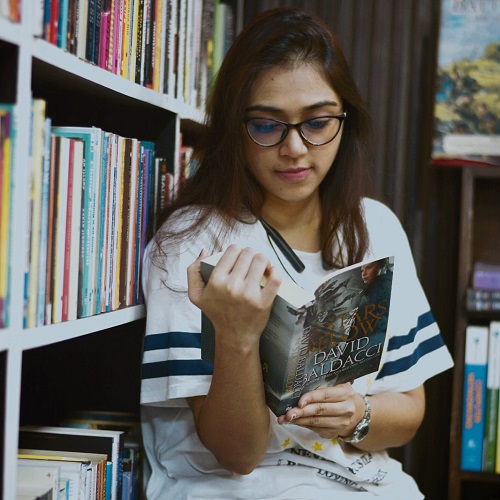
I am Sanchita, and books are my life force. I live and breathe stories. Getting lost in fictional worlds has been my favorite thing to do for as long as I can remember. Over the course of 20 years, I have read over a thousand books and here I have come to talk about them.
